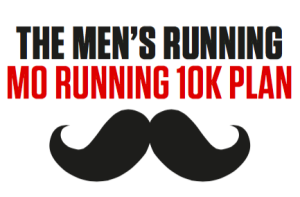Running one of Mo Running’s 10Ks to support the Movember Foundation (www.mo-running.com)? Then read how to tackle the distance here. And click here to download your exclusive Men’s Running and MoRunning 10K training plan!
Nailing a 10K is a real balancing act. Too short to plod but too long to sprint, the distance requires both physical fitness and mental know-how. The good news is, running the 6.1miles won’t hammer your legs like a full or half-marathon, so there’s plenty of opportunities to practise getting it right. Ultimately, to truly race 10K to your potential, you’ve got to board the pain train and ride it right through to the finish. Training fast and putting yourself on the edge of comfort in races will help you to do this.
Things you’ll need to run a fast 10K
1. A strong aerobic foundation and good base endurance. You’ve got to have some miles in your legs to build on.
2. A decent turn of top-end speed. Taking your 10K to the limit means mastering faster running.
3. The ability to hold a high percentage of your maximum effort. Running a 10K PB is about walking the knife-edge of aerobic tolerance. It’s about being on the threshold of comfort for 6.1miles – and then tipping over but holding on!
4. An economical and efficient running action. You don’t want to waste energy. You need to be strong and powerful but also smooth and effective.
5. A tolerance of pain. Once all the physical training is done, the racing part is in your head. Clever 10K racers master suffering.
The training
Let’s cut to the chase here. Lots of easy running won’t help you run a faster 10K. Running longer won’t necessarily help, either.
So instead of heading out for another sleep-inducing steady plod, mix up your miles and include the golden nuggets of 10K training: threshold, race pace and speed workouts.
Threshold
The key to taming the 10K lies in mastering your ‘threshold’ pace. Threshold running is the type of training you know you should do but often don’t. Why? Because it hurts. Best described as ‘controlled discomfort’, threshold pace sees you running on the edge of your aerobic tipping point – as effectively and efficiently as you can. You’ll still be in control, but you’ll need to focus and concentrate on maintaining this pace for any sustained amount of time. In terms of effort, threshold running equates to about 80% of your maximum. Like any form of running, the more you do of it, the better you get at it. What this means, in reality, is that you’ll be able to run faster but at a lower relative intensity – perfect for 10K.
Don’t be too ambitious when you start threshold running. Build your tolerance gradually. Kick off with short sections of a run (2-4mins with recovery) and build to longer efforts (4-10mins) and ultimately to sustained threshold workouts (20-40mins).
Race pace
To race a great 10K, you should be teaching your body to tolerate anticipated race-day pace, intensity and duration. Interval (or repetition) running is a proven tool for 10K success. Great 10K intervals improve VO2 max, build strength and speed endurance, and should be run quicker than threshold efforts to develop faster running. Intervals for 10K might be run at 85-90% effort level. They can be done at ‘target 10K’ race pace (for example, 6 x 1K with 2mins recovery) or even a touch faster (10 x 0.5K at 3-5secs per/km faster than 10K target race pace) and should be separated with varying amounts of recovery depending on the phase and purpose of training. Single-session 10K interval sessions can be made up of repetitions that cover 10K or more in distance.
Speed
If faster 10Ks are your goal, speed work is a must. These sessions will see you running faster than your target race pace. Speed training will definitely get you out of breath, with your heart pounding and muscles screaming. That’s the point.
Completing a speed workout means fast running. ‘Fast’ is, of course, a relative term and will vary on your level of fitness. What you can control, however, is your effort. To get the most from speed work, your effort levels have to be high (90% of your maximum). Once again, great 10K speed sessions are best structured as shorter intervals. Longer recovery between bouts of effort ensures quality of intensity during faster runs can be effectively maintained. Don’t be afraid to take plenty of time to recover before hitting the fast stuff again. For example, 6 x 60secs with 3mins recovery between each. It’s always a good idea to look for a surface conducive to fast running. Seek out well maintained grass pitches, running tracks or sections of flat trail or road. Avoid uneven surfaces or anything that will break your stride or slow you down.

Get the right balance
To run a quick 10K, you need to be training at a variety of speeds. Often, changing a small part of your routine can make a big difference – for example, swapping a steady run for a high-intensity interval session once a week.
As a distance, the 10K demands that you are a great all-round runner. You need to be strong enough to cope with the distance, efficient enough to tolerate the intensity load of a sustained amount of time, and fast enough to turn on the burners when you need to.
This means including different elements of training at different times in your programme. You’ll know where your 10K weaknesses lie. Crack a regular threshold session, shorten your recoveries, run faster than before or join a speedier running group. Get out of your comfort zone for a while and the results could be astonishing.
Structure your plan of attack. Overall, it should include elements that will build your strength, stamina and speed.
Follow the below training principles to keep on track:
Mind games
You need a strong mindset to master the 10K. You know it’s going to hurt, especially in second half, and you need to be ready for this.
Before the race begins:
• Stay calm. Complete a warm-up routine that works for you. It needs to physically and psychologically prepare you for what’s to come.
• Go through your race strategy and some race scenarios.
• Believe in your ability to execute your plan. You’ve done the training and are ready.
• Positively visualise your success. See yourself running strongly and achieving your goals.
During the race:
• Commit early. It’s natural to have a wobble during the race and start to doubt your ability to make the finish but at the same time you have to commit. To run a great 10K, you can’t spend the first half of the race gently getting into it. You’ve got to be hitting your target race pace quickly and focusing on holding it for each mile. Break the 10K down into 10 x 1K or 6 x 1mile and focus only on hitting your desired time for each unit. Tick them off.
• Settle down. Get into a smooth rhythm. Feel controlled and strong. Take inspiration from those around you.
• Block out distractions. Tune in to your body and how you are feeling to stay on pace. Do what you’ve done in training.
• Be relentless. You won’t nail your 10K by being easy on yourself. Climb into the hurt locker and keep going.







